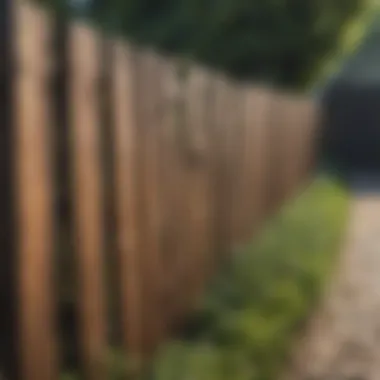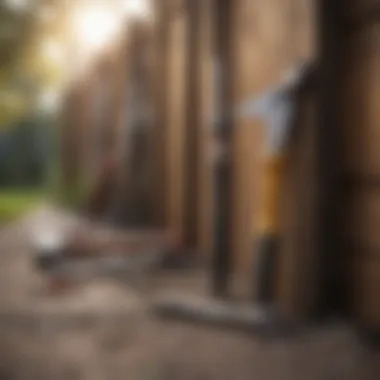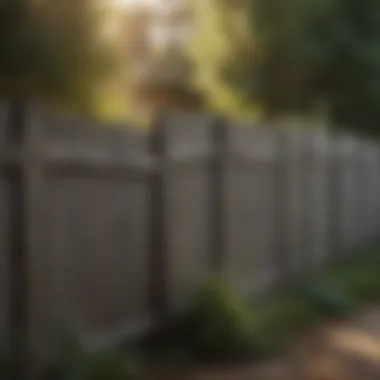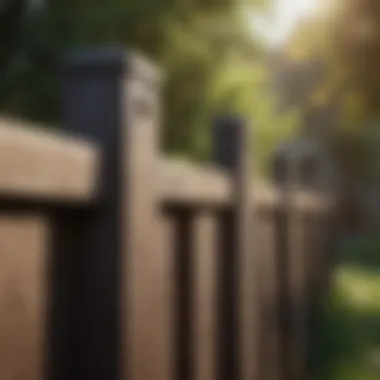Repairing a Leaning Fence: Homeowner's Guide


Intro
Maintaining the functional and aesthetic value of a property often involves regular upkeep of various elements that contribute to its charm. A crucial aspect that may be overlooked is the condition of a fence. A leaning fence not only detracts from the visual appeal of your outdoor space, but may also signal underlying structural issues. Understanding how to repair a leaning fence is essential for homeowners looking to preserve their property’s integrity.
This comprehensive guide will delve into the primary causes of a leaning fence, effective repair methods, and ongoing maintenance strategies to prevent future issues. By arming homeowners with the necessary knowledge, the aim is to empower a proactive approach in dealing with this common problem.
The journey of repairing a leaning fence will include design inspirations, practical tips for maintenance, and budgeting considerations, ensuring a well-rounded understanding of the topic that goes beyond mere repairs.
Preamble to Leaning Fences
When it comes to maintaining a property, a leaning fence is more than just an unsightly nuisance. It signifies potential structural issues that, if left unaddressed, could lead to further complications. This section aims to provide insight into the importance of recognizing and understanding leaning fences. Homeowners should prioritize awareness of these issues because fences not only serve aesthetic purposes but also mark property lines, provide privacy, and contribute to security.
Understanding Leaning Fences
A leaning fence usually indicates an underlying problem. This could stem from natural events, such as heavy rainfall or wind, or from improper construction techniques. An understanding of leaning fences starts with recognizing that the cause may not be immediately visible. It requires keen observation. Look for posts that tilt in one direction, gaps between the fence and the ground, and other physical signs that could point to instability. Such elements are critical for determining the necessary steps to restore the fence's integrity.
Common Signs of Fence Leaning
Identifying the common signs of a leaning fence is essential for timely repairs. Here are some indicators to consider:
- Tilting Posts: Posts should stand vertical. A noticeable tilt suggests that there may be instability in the soil or the post itself.
- Gaps: If there are gaps between the fence and the ground, it often means the post is sinking or moving, disrupting the overall alignment.
- Warped Panels: If the panels themselves show signs of warping or twisting, this could indicate a more serious issue with the fence's frame or its foundation.
- Unusual Movement: When wind or incidental contact causes excessive movement of the fence panels, it might be time to assess the stability of the structure.
It's important to address leaning fences quickly, as neglecting them may lead to complete fence failure and may even impact neighboring structures.
In summary, recognizing the characteristics of leaning fences plays a crucial role in assessing the need for repairs. Homeowners should remain observant of their fences to maintain both their functionality and visual appeal.
Identifying Causes of Leaning
Understanding the reasons behind a leaning fence is critical for making informed repair decisions. Identifying these causes not only aids in devising an effective solution but also prevents future issues from arising. A fence that leans is often a symptom of underlying problems left unaddressed.
Being aware of these causes enhances the approach to repairs, ensuring that efforts focus on the root of the problem rather than just correcting the visible lean. This section addresses the primary factors that contribute to a leaning fence and offers insights into their implications.
Soil Erosion
Soil erosion can significantly impact the stability of a fence. Over time, natural elements like rain and wind can wash away soil that anchors fence posts. As the soil diminishes, the support for the posts weakens, leading to a gradual lean. Homeowners should assess the landscape regularly, looking for signs of erosion.
To combat erosion, homeowners can take the following steps:
- Implement Ground Cover: Planting grass or other vegetation can help hold soil in place.
- Use Retaining Walls: In areas prone to erosion, consider building a low wall to stabilize the soil.
- Ensure Proper Grading: Slope the yard away from fence posts to reduce water pooling near them.
Rotting Posts
Another common cause of a leaning fence is rotting posts. Many wooden fences suffer from moisture exposure that leads to decay. When a post rots, its structural integrity weakens, resulting in instability. Homeowners should inspect each post periodically, especially at the base, where rot typically begins.
Key indicators of rotting include:
- Softened Wood: If the wood feels spongy or crumbles easily, it may be decaying.
- Mold or Fungus Growth: Dark patches or fungus growth are signs of excessive moisture.
- Visible Cracks or Splits: Check for cracks, as these can signify internal damage.
Should a post be found rotting, it is essential to replace it promptly to maintain the fence’s alignment.
Extreme Weather Conditions
Extreme weather conditions can have a profound effect on fence stability. High winds, heavy rains, and freezing temperatures can create stress on the fence structure. For instance, sustained strong winds can push a fence over time, causing it to lean over time.
Homeowners should consider the following preventive measures:
- Reinforce Fences: Use braces or additional supports in areas prone to high winds.
- Assess Post Depth: Ensure that posts are buried deep enough to withstand weight and movement.
- Use Weather-Resistant Materials: Opt for materials that can endure harsh conditions and reduce the likelihood of damage.


Poor Installation Practices
Inadequate installation can lead to significant long-term issues. If the fence posts are not set deep enough or the materials are subpar, leaning can occur quickly. Fences require a solid foundation for optimal performance, and miscalculations during installation can lead to instability.
To ensure a well-installed fence:
- Follow Manufacturer Guidelines: Adhere closely to instructions regarding post depth and spacing.
- Use Appropriate Concrete Pouring Techniques: Properly poured concrete can greatly enhance post stability.
- Avoid Rushed Installations: Take the necessary time during installation. Quality should take precedence over speed.
Remember, the key to effective fence repair begins with understanding its causes. Addressing these issues early can save homeowners from more extensive repairs later on.
Tools and Materials Required
Repairing a leaning fence demands careful selection of tools and materials. The appropriate tools ensure efficiency, while quality materials contribute to a durable and stable repair. Understanding these elements is crucial for homeowners who wish to restore their fences effectively. Without the right tools, even the best plans can falter. Similarly, using subpar materials can lead to recurring problems in the future. This section will guide you through essential tools and materials needed for this repair process.
Basic Tools
When embarking on a fence repair project, having the right tools is non-negotiable. Some of the basic tools needed include:
- Post Hole Digger: Necessary for digging holes for new posts. It allows precise and clean digging to set new posts.
- Level: Essential for ensuring that the fence remains straight during repairs. This tool helps in achieving proper alignment after realignment.
- Screwdriver: Required for fastening screws or adjusting existing parts of the fence. A power screwdriver generally speeds up the process.
- Tape Measure: Fundamental for ensuring accuracy in measurements. Incorrect measurements can lead to significant issues during installation.
Materials for Repair
Choosing the right materials is as vital as having the right tools. Here are key materials that play a role in the repair of a leaning fence:
Concrete Mix
Concrete mix is a fundamental material in this context. It is crucial for stabilizing new fence posts and reinforcing existing ones. The primary characteristic of concrete mix is its strength once dried. This strength makes it a popular choice for fencing repairs. A unique feature of quality concrete is that it expands slightly as it dries, filling gaps and securing posts even more firmly. While concrete mix is advantageous due to its durability, it requires adequate drying time, which can be perceived as a downside by some.
Support Braces
Support braces serve to prop up leaning sections of the fence temporarily. These braces are vital during the repair process. A key characteristic of support braces is their ability to stabilize the structure while work is being done. They are often made of wood or metal, offering flexibility in terms of material choice. One unique feature of these braces is that they can be adjusted for tension, allowing for better support tailored to specific needs. However, reliance on temporary braces means they must be removed once permanent solutions are established.
New Fence Posts
New fence posts become essential when existing posts are too damaged to salvage. These posts should be robust and weather-resistant to ensure long-term integrity. A crucial aspect of new fence posts is their durability against rot and pests. Using treated wood or composite materials makes these posts an excellent investment. The unique feature of modern fence posts is that they can come with built-in features like a molded base to prevent water accumulation. The main downside might be the initial costs involved in securing quality posts, but considering the long-term benefits, it is usually worth it.
Preparing for Repairs
Preparing for repairs is a crucial step in the process of fixing a leaning fence. This phase involves careful evaluation and strategic planning to ensure the repair is effective and long-lasting. Taking the time to assess the situation can save homeowners from further complications down the line. This stage is not just about fixing what is visible; it requires a thorough understanding of the underlying issues that led to the leaning.
Assessing the Damage
Assessing the damage is the first task in the preparation phase. Homeowners should closely examine the fence to identify specific problems. Start by checking the fence posts for signs of rot or decay. Look for discoloration or soft spots on wooden posts. These indications may suggest that the support is compromised.
Next, observe the alignment of the fence. Is it leaning significantly? If so, measure how far it has deviated from its original position. A simple level can help with this. Additionally, look at the surrounding soil; erosion or irregular settling may contribute to the leaning. Poor drainage is another factor to consider, as it can lead to water pooling around the posts.
Keep a notebook to document your findings. This record will assist in creating a clear repair plan later.
Creating a Repair Plan
Once damage assessment is complete, creating a repair plan is essential. Start by summarizing the main issues identified during the assessment. This may include replacing rotting posts, adding support braces, or addressing soil erosion. Next, set priorities for the repairs based on your observations.
Consider the following points while making a plan:
- Identify the specific tools and materials needed for each task.
- Determine whether you need professional help for certain repairs or if it can be a DIY project.
- Set a timeline for when you aim to complete the repairs.
This level of organization will help ensure that all required tasks are addressed systematically. The repair process can become chaotic without a clear plan, leading to missed areas or potential rework. A structured approach not only saves time but also enhances the overall effectiveness of your repair efforts.
"Proper preparation prevents poor performance."


Focus on preparing adequately before starting the actual repair. This will enhance the chances of successfully restoring your fence to a straight and stable position.
Repair Techniques
Repair techniques are essential for restoring a leaning fence to its intended function and appearance. Effective repair strategies are vital not only for the stability of the fence but also for protecting property value and enhancing landscape aesthetics. In this section, we will explore various methods to effectively address fence leaning through specific repair techniques.
Reinforcing Leaning Sections
Reinforcing leaning sections can help restore balance to a compromised fence. This technique involves adding temporary or permanent supports to stabilize the leaning parts. It is essential to perform this step promptly to prevent further leaning or damage from worsening.
There are several methods to reinforce leaning sections. You can use braces made of wood or metal for temporary fixes. If the lean is minor, installing diagonal supports from the lower part of the fence post to undamaged ground can help. For more significant issues, consider using galvanized metal brackets attached between the post and the adjacent solid structures. This ensures stability while you plan long-term solutions.
Additionally, check the surrounding soil to ensure it can bear the weight. It is important to monitor the adjustments made during this phase closely. Any sign of movement in a reinforced area requires immediate attention. This technique provides an opportunity for a practical solution while maintaining the aesthetic value of the overall fence structure.
Replacing Damaged Posts
Replacing damaged posts is another critical repair technique. Over time, posts can deteriorate due to rot, insect damage, or environmental factors. If a post is significantly leaning or damaged, it’s best to replace it to maintain the integrity of the fence.
Begin by assessing the damage. If the post shows signs of rot or major cracks, remove it carefully with a post puller or pry bar. Be sure to take out any concrete or dirt that surrounds it. Once removed, position a new post in the hole and ensure it is level and straight.
Secure the post in place by pouring concrete mix around it and allowing it to set. Using quality materials such as pressure-treated wood or composite posts can prolong the lifespan of your fence. Ensuring that the replacement aligns with remaining posts will restore uniformity.
Realigning the Fence
Realigning the fence is often the final step after reinforcing and replacing damaged posts. This process involves adjusting the overall position of the fence to ensure it stands straight. As important as it may seem, realignment can often lead to a striking improvement in the visual appeal of the fence and the entire yard.
Start by checking the alignment of the posts using a level and measuring tape. Remove any fasteners that may be holding the fence panels too tightly against a leaning post, giving them a chance to reposition. Using a mallet, gently tap sections of the fence into their required position. You can temporarily hold them in place with stakes or blocks.
After adjustments, make sure everything is level before tightening the fasteners back into place. It’s advisable to check alignment regularly to prevent the fence from leaning again in the future. This technique not only enhances the security provided by your fence but also showcases a well-maintained property.
Post-Repair Assessment
Assessing the condition of a fence after repairs is vital. It ensures that all efforts made during the repair process effectively restore stability and appearance. Homeowners should make the post-repair assessment a priority to verify that the adjustments have been successful and to prevent future issues. The assessment is not just about ensuring the fence looks good but also about guaranteeing its longevity.
Evaluating Stability
Evaluating the stability of a fence post-repair involves several key factors. One primary consideration is the alignment of the fence. Homeowners should visually inspect whether the fence maintains an even height along its length. Use a level tool to check this if necessary. If any section still appears to lean, further support may be required.
Another important component is checking the firmness of the posts. Each post should be firm upon pressure; if it shifts easily, this indicates inadequate installation or post fixity. Inspect the soil around the posts. It should be tightly compacted, especially after adding concrete or any stabilizing material. Finally, checking for movement during windy conditions can provide insights into stability. Any noticeable sway suggests the need for adjustments.
"Post-repair evaluations are not merely a formality; they are essential to ensure that your fence will withstand time and elements."
Aesthetic Considerations
While stability is critical, the appearance of the fence also matters. An aesthetically pleasing fence contributes to the overall value of a property. After repairs, take note of any visible irregularities. This includes mismatched paint, uneven heights between panels, or poorly aligned posts. It can help to step back and view the fence from different angles to get an overall sense of its appearance.
If repainting or staining was not part of initial repairs, consider how the existing coloring blends with surrounding structures and landscape. A fresh coat can enhance not only the fence itself but also the surrounding area.
Additionally, homeowners should think about how repairs impact the overall design. A fence should complement the home and garden, creating a seamless look. If the new parts of the fence appear outdated or too distinct, steps may be needed to harmonize their appearance.
Overall, post-repair assessment should be done with both stability and aesthetics in mind. Taking the time to evaluate both ensures that homeowners enjoy the functional and visual benefits of a well-maintained fence.
Preventive Measures
Preventive measures play a crucial role in maintaining a fence's stability over time. By incorporating proactive practices into your regular routine, you can significantly reduce the chances of your fence leaning or sustaining damage. This section will examine essential aspects of preventive measures, focusing on the benefits and considerations that homeowners should keep in mind.
Regular Inspections


Regular inspections are fundamental to ensuring the long-term integrity of a fence. Homeowners should set aside time every few months to check for any signs of deterioration. Look for leaning sections, cracks in wood, or any displaced posts. Additionally, pay attention to the fence's alignment and notice any changes that may suggest underlying issues.
In terms of process:
- Walk the length of the fence and check for sagging or bending.
- Inspect the base of the fence posts for signs of rot or pest activities.
- Look for any vegetation or debris that could potentially affect the foundation.
Regular assessments not only keep you aware of any developing problems but also allow for timely interventions when issues arise.
Soil Management Techniques
Soil stability is one of the most critical factors to consider in fence maintenance. The soil surrounding your fence posts should be properly managed to prevent erosion or shifting. Erosion can be exacerbated by heavy rains or poor landscaping choices. To combat this:
- Implement ground cover plants that help bind soil together and reduce erosion.
- Use mulch around the fence base to absorb rainwater and prevent washout.
It is also advisable to check the composition of the soil. Soil that is too sandy may not provide adequate support for posts, while overly compacted soil can lead to water pooling. Making adjustments such as adding structural materials can reinforce the soil support around your fence posts.
Effective Drainage Solutions
Proper drainage around your fence is essential in preventing moisture from accumulating at the base of the posts. Poor drainage is a leading cause of fence leaning, as waterlogged soil can lead to the rotting of wooden posts. Homeowners should assess the natural flow of water on their property and implement strategies to manage it effectively. Here are some approaches to consider:
- Install a French drain system to redirect water flow away from the fence.
- Elevate the fence line if possible, to encourage water runoff.
- Adjust landscaping features to avoid creating basins where water can collect.
By ensuring that water moves away from the fence effectively, you help maintain the soil’s integrity, supporting the fence’s alignment and overall durability.
"Proactive maintenance and management can save homeowners the headache of more significant repairs down the line."
By following these preventive measures, homeowners can enhance their fence's longevity and minimize repair needs. Regular inspections, soil management, and effective drainage form a trifecta of strategies that support the overall stability of fences.
Maintaining Fence Integrity
Maintaining the integrity of a fence is crucial for both functionality and aesthetics in any outdoor space. A well-maintained fence not only provides privacy and security but also enhances the overall appeal of your property. Therefore, paying attention to its condition can prevent more significant issues down the line. Regular maintenance practices and seasonal preparations can ensure that your fence stands strong against the elements and retains its visual appeal.
Routine Maintenance Practices
Carrying out routine maintenance can significantly extend the life of your fence. Here are some essential practices:
- Inspect Regularly: At least twice a year, inspect your fence for any signs of wear or damage. Look for cracks, rotting wood, or loose panels.
- Clean the Surface: Remove dirt, debris, and any growth like moss or weeds around the base. A pressure washer can help, but be careful not to use too much force which can damage the fence.
- Treat for Insects and Rot: Apply treatments to prevent insect infestations and rot. Products specifically designed for outdoor wood can provide a protective layer against moisture and pests.
- Repaint or Reseal: If your fence is painted or stained, check that the finish is intact. Reapply paint or sealant as needed to protect against the weather. This can also keep the fencing looking fresh and vibrant.
By following these practices, you contribute to a fence that not only functions well but also improves the overall aesthetic of your yard.
Seasonal Preparations
Each season brings its unique challenges for fence maintenance. Preparing your fence for seasonal changes can mitigate potential damage:
- Spring: Inspect after winter has passed. Look for any storm damage and address it. Clean the fence and apply new sealant if necessary to combat the wet weather.
- Summer: Monitor for signs of sun fade and heat damage. Ensure that plants or shrubs are not growing too close to the fence, as they can push against it.
- Fall: Clear away fallen leaves and debris that can retain moisture and cause rot. This is also a good time to check for any necessary repairs before winter.
- Winter: Remove heavy snow build-up to prevent bending or breaking of the panels. Ensure that drainage around the base is adequate to prevent water accumulation.
By being proactive about seasonal preparations, you can help your fence withstand the rigors of changing weather conditions.
Maintaining the integrity of your fence not only preserves its structural stability but also enhances the overall beauty of your property. Regular attention is key.
Epilogue
The maintenance and repair of a leaning fence is a critical topic for homeowners who value not just the functionality but also the aesthetic of their property. A well-aligned fence serves multiple purposes. It provides security, delineates property lines, and contributes to the overall appearance of the landscape. When a fence leans, these functions can be compromised, leading to a need for timely intervention.
Final Thoughts on Fence Repair
Repairing a leaning fence requires a clear understanding of the causes and effective solutions. Homeowners must assess their situation systematically. Engaging in repairs can not only restore structure but also enhance property value.
- Stability is Key: A stable fence offers long-term benefits, reducing future repair costs.
- Aesthetic Appeal: Aligning the fence can improve the visual coherence of the outdoor space.
- Resource Efficiency: Understanding repair techniques ensures that time and resources are used effectively, minimizing waste.
It is essential to prioritize both aesthetics and functionality. Regular maintenance checks coupled with prompt repairs can prevent small issues from evolving into larger, more costly problems.
"A leaning fence can signal neglect but addressing it promptly can reflect pride in homeowners' stewardship of their property."
Investing time into understanding the nuances of fence repair leads to informed decisions. Homeowners should feel empowered to take action, ensuring their fence stands firm and looks good.















